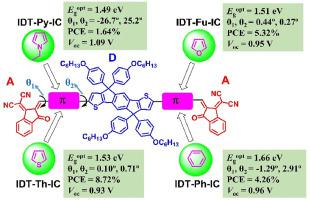Organic Electronics ( IF 2.7 ) Pub Date : 2020-11-25 , DOI: 10.1016/j.orgel.2020.106015 Yueju Chen , Jingtang Liang , Yufu Yu , Linqiao Wang , Chao Weng , Ping Shen

|
Investigation on the relationship between molecular structure and device performance is of great important to develop highly efficient A-π-D-π-A small molecular acceptors (SMAs). However, there is still lack of a complete and in-depth study on effects of π-bridge on molecular structure, optoelectronic properties and photovoltaic performances. Herein, we reported the design, synthesis and photovoltaic application of four A-π-D-π-A type SMAs, denoted as IDT-Py-IC, IDT-Fu-IC, IDT-Th-IC, and IDT-Ph-IC, which possess an identical central D unit of indacenodithiophene and the terminal A group of 3-(dicyanomethylidene)indol-1-one, linked by various aromatic π-bridges of pyrrole, furan, thiophene, and benzene, respectively. The impact of the different aromatic π-bridge on molecular structures, optoelectronic and photovoltaic properties as well as active layer morphologies was comprehensively explored. Results show that both molecular co-planarity and electron-donating ability of aromatic π-bridges distinctly affect optical bandgaps (Egopt) and HOMO/LUMO levels of these SMAs. The poor backbone planarity of pyrrole-bridged IDT-Py-IC observed by theory calculation leads to a blue-shifted absorption and up-shifted HOMO/LUMO levels. The Egopt of these SMAs is gradually increased and HOMO levels are gradually down-shifted with the decrease of the electron-donating ability of aromatic π-bridges. Polymer solar cells (PSCs) based on these SMAs exhibit a high Voc over 0.93 V, especially for PBDB-T:IDT-Py-IC-based PSCs, producing a rather high Voc up to 1.06 V due to the high-lying LUMO level. After optimizations, the PBDB-T:IDT-Th-IC-based PSC outperforms the other three SMAs with a high PCE up to 8.72% mainly due to the large Jsc and FF, which could be ascribed to better absorption characteristics, higher and more proportional carrier mobility, efficient exciton dissociation and charge collection, reduced bimolecular recombination and superior active layer morphology. This finding demonstrates that the π-bridge plays a crucial role in tailoring molecular structures, optoelectronic properties and device performance of A-π-D-π-A type SMAs.
中文翻译:

芳族π桥对茚并二噻吩基A-π-D-π-A小分子受体分子结构和光电性能的影响
研究分子结构与器件性能之间的关系对于开发高效的A-π-D-π-A小分子受体(SMA)至关重要。然而,关于π桥对分子结构,光电性能和光伏性能的影响,仍然缺乏完整而深入的研究。在这里,我们报道了四种A-π-D-π-A型SMA的设计,合成和光伏应用,分别表示为IDT-Py-IC,IDT-Fu-IC,IDT-Th-IC和IDT-Ph-我知道了,它们具有相同的茚并二噻吩中心D单元和3-(二氰基亚甲基)吲哚-1-酮的末端A基团,分别通过吡咯,呋喃,噻吩和苯的各种芳族π-桥连接。全面探讨了不同的芳族π桥对分子结构,光电和光伏性能以及活性层形态的影响。结果表明,芳香族π桥的分子共平面性和给电子能力均明显影响这些SMA的光学带隙(E g opt)和HOMO / LUMO水平。通过理论计算观察到,吡咯桥联的IDT-Py-IC的骨架结构不佳会导致吸收蓝移和HOMO / LUMO上移。该Ë克选择这些形状记忆合金的逐渐增加和HOMO水平逐渐与芳香π桥的供电子能力下降下移。基于这些SMA的聚合物太阳能电池(PSC)在0.93 V之上表现出较高的V oc,特别是对于PBDB-T:基于IDT-Py-IC的PSC,由于其高电位,产生高达1.06 V的较高V oc LUMO级。经过优化后,PBDB-T:基于IDT-Th-IC的PSC优于其他三个SMA,其PCE高达8.72%,这主要是由于J sc较大和FF,这可以归因于更好的吸收特性,更高和更大比例的载流子迁移率,有效的激子离解和电荷收集,减少的双分子重组和出色的活性层形态。这一发现表明,π桥在调整A-π-D-π-A型SMA的分子结构,光电性能和器件性能方面起着至关重要的作用。











































 京公网安备 11010802027423号
京公网安备 11010802027423号